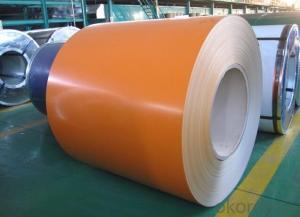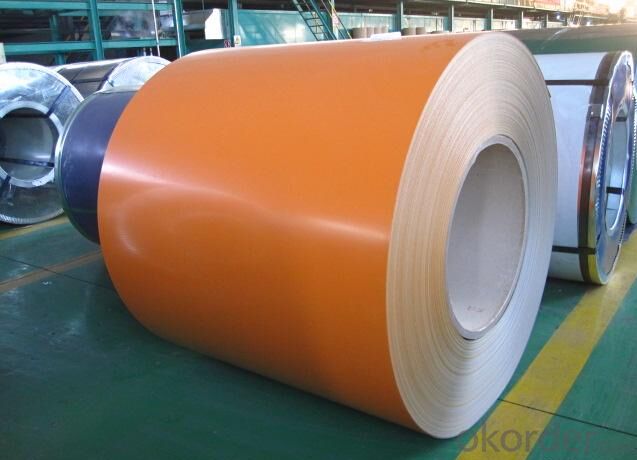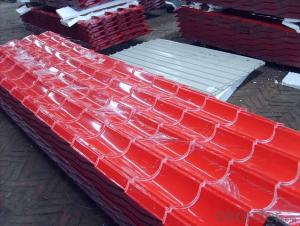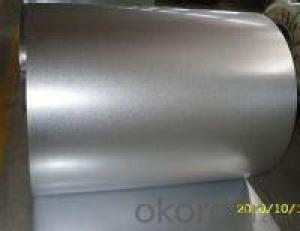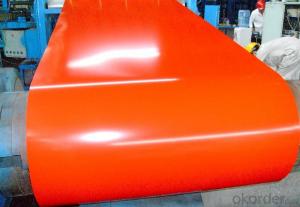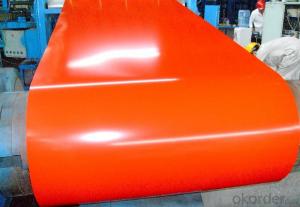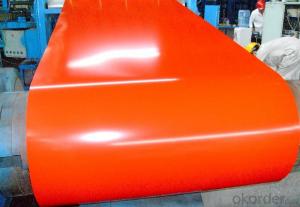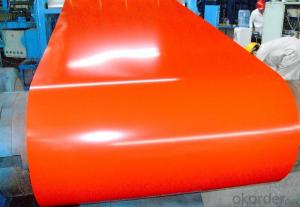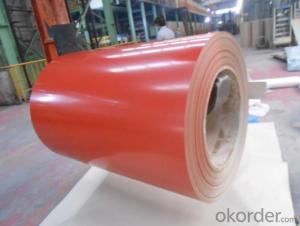Pre-Painted Galvanized/Aluzinc Steel Sheet in Coils with Prime Quality in Orange Color
- Loading Port:
- Shanghai
- Payment Terms:
- TT OR LC
- Min Order Qty:
- 100 m.t.
- Supply Capability:
- 10000 m.t./month
OKorder Service Pledge
OKorder Financial Service
You Might Also Like
1. Pre-Painted Galvanized/Aluzinc Steel Coil Description:
With GI as base material, after pretreatment (degrease and chemical treatment ) and liquid dope with several layers of color, then after firing and cooling, finally the plate steel is called pre-painted galvanized (aluzinc) steel. Pre-painted galvanized steel is good capable of decoration, molding, corrosion resistance. It generally displays superior workability, durability and weather resistance.
2.Main Features of the Pre-Painted Galvanized/Aluzinc Steel Coil:
• Excellent process capability
• Smooth and flat surface
• Workability, durability
• Excellent heat resistance performance
• High strength
• Good formability
• Good visual effect
3.Pre-Painted Galvanized/Aluzinc Steel Coil Images
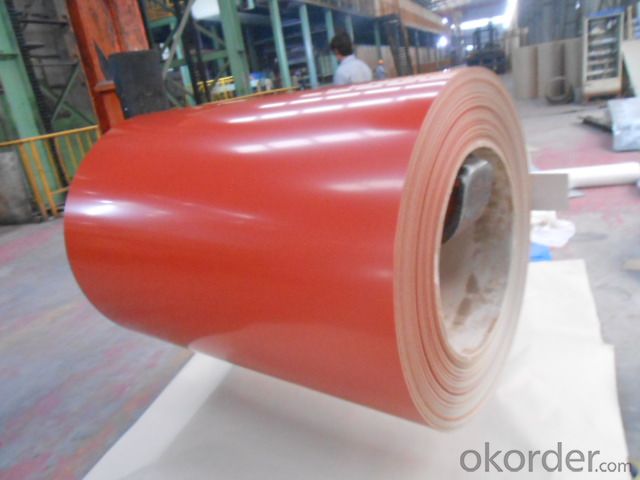
4.Pre-Painted Galvanized/Aluzinc Steel Coil Specification
Standard: AISI, ASTM, BS, DIN, GB, JIS
Grade: DX51D, DX52D
Thickness: 0.17-2.0mm
Brand Name: KMRLON
Model Number: coil
Type: Steel Coil
Technique: Cold Rolled
Surface Treatment: Coated
Application: Boiler Plate
Special Use: High-strength Steel Plate
Width: 20-1250mm
Length: customized
commoidty: pre-painted galvanized steel coil
Thickness: 0.13-4.0mm
width: 20-1250mm
zinc coating: 40-180g/m2
printing thickness: top side: 20+/-5 microns, back side: 5-7 microns
color: ORANGE color
surface treatment: color coated
coil weight: 4-7 tons
coil ID: 508/610mm
packaging: standard seaworthy packing
5.FAQ of Pre-Painted Galvanized/Aluzinc Steel Coil
1. What’s the application of this product?
Roof, roof structure, surface sheet of balcony, frame of window, etc.
2. What’s the brand of the paint?
We use the best brand of all of the word—AKZO.
3. How about your company?
A world class manufacturer & supplier of castings forging in carbon steel and alloy steel,is one of the large-scale professional investment casting production bases in China,consisting of both casting foundry forging and machining factory. Annually more than 8000 tons Precision casting and forging parts are exported to markets in Europe,America and Japan. OEM casting and forging service available according to customer’s requirements.
4. How to guarantee the quality of the products?
We have established the international advanced quality management system,every link from raw material to final product we have strict quality test;We resolutely put an end to unqualified products flowing into the market. At the same time, we will provide necessary follow-up service assurance.
5. How long can we receive the product after purchase?
Usually within thirty working days after receiving buyer’s advance payment or LC. We will arrange the factory manufacturing as soon as possible. The cargo readiness usually takes 15-25 days, but the shipment will depend on the vessel situation.
- Q: All the appliances in my kitchen are stainless steel, and I hate how they look becuase every time I wash them they are full of streaks. Is there a good cleaner made for stainless steel that won't leave streaks?
- I love Zep Stainless Steel Cleaner. It doesn't leave streaks, it is a foam on easy application and it leaves a protective coating that resists fingerprints and food from sticking on the surface. I even use it on my stainless cooktop and it gets off burned on food, too. I get it at the Home Depot and a big can lasts a long time.
- Q: I have a new stainless steel trash compactor under a butcher block counter. We refinished the countertop, but unfortunately the person who did it wasn't careful with the orbital sander and sanded the top edge of the stainless steel compactor door, ruining the finish. The sander marks are not deep - just surface scratches - but they are unsightly. Is there any way to restore the finish to the stainless steel without having to buy a new door?
- Scratches are difficult to remove. Most kitchen appliances, sinks, and counters have a polished finish with short directional polishing lines. Restoring a polished finish to its original appearance requires a professional such as a company that specializes in fabricating or polishing stainless steel. If the refrigerator or dishwasher door panel is replaceable, purchasing a new panel is normally more cost effective than professional refinishing. The homeowner may want to consider obtaining replacement panels with angel hair, distressed, swirl, or embossed finish. These finishes help to hide light scratching and can be obtained from companies that specialize in stainless steel finishes. Counters and appliance doors that are not easily removable must be refinished in place. When the counter is refinished, it may have long rather than short polishing lines. If a slightly different finish is acceptable and cost is a consideration, a homeowner can refinish the counter or appliance using a non-metallic abrasive pad such as a Scotch Brite? pad. This can be done by rubbing the surface with the pad using long uniform strokes in the same direction as the current polishing lines. This will not eliminate deep scratches. A professional may offer this finish as a less expensive option. The resulting finish is normally referred to as a hairline or long grain finish. Some appliance companies are starting to offer this finish.
- Q: On a free standing carport with an 8 inch, 22 foot long aluminum i-beam, would a steel 8-inch i-beam be just as strong? I am looking into it since they are cheaper.
- Structural steel is stronger than structural aluminum. If the structural design is adequate for using an 8 structural aluminum I beam, you can certainly use an 8 structural steel I- beam and if the price is better, you can also use a 10 structural steel light weight channel. If it is on the coast, prime it well and keep it painted. Potential corrosion trouble spots and fasteners can be sprayed with automotive undercoating.
- Q: How are steel coils processed for cold rolling or hot rolling?
- Steel coils are processed for cold rolling or hot rolling through a series of steps. For cold rolling, the steel coils are first cleaned and pickled to remove any impurities. They are then passed through a series of rolling mills, where the steel is gradually reduced in thickness and elongated. This process improves the steel's strength and surface finish. In contrast, for hot rolling, the steel coils are heated to high temperatures and then passed through a series of rolling mills. The hot rolling process allows for greater deformability and shaping of the steel, resulting in different thicknesses and shapes.
- Q: How are steel coils processed for stamping or forming?
- Steel coils are processed for stamping or forming through a series of steps. First, the coils are uncoiled and straightened to remove any bends or twists. Then, they are fed into a stamping or forming machine, where the desired shape or pattern is formed by applying pressure. After the stamping or forming process, the excess material is trimmed or cut off, and the finished parts are inspected for quality.
- Q: If you keep it dry and clean, what steel will last the longest over the years with continued use and sharpening?
- you eventually will wear the blade out. i have seen old guys pocketknives that they used for whittlin and the blades have deep curves in them like khukris from wear. i reccommend, 440 stainless, or something with a rockwell hardness rating above 45.
- Q: What are the different methods of cutting steel coils into sheets?
- There are several methods used to cut steel coils into sheets, including shearing, slitting, and laser cutting. Shearing involves using a large, powerful machine to cut through the coil with a straight blade. Slitting involves passing the coil through a set of circular blades that gradually reduce its width, creating multiple narrower sheets. Laser cutting uses a high-powered laser beam to precisely and rapidly cut through the coil, offering a versatile and efficient method.
- Q: How are steel coils inspected for edge quality?
- Steel coils are inspected for edge quality through visual examination, measuring thickness and width, and conducting various tests such as bend tests and surface inspections.
- Q: What are the commonly used molds steel?
- floor scientific care of different types, I communicate approximately features of chilly paintings die metallic warmth scientific care: chilly paintings mold metallic alloying aspects quantity and style are plenty, alloying is quite complicated. The detrimental thermal conductivity of metallic, the austenitizing temperature is bigger, so the heating technique slowly, preheats or cascade warmth greater. to guard the floor of the metallic high quality, heating medium must be heavily, so the controlled ecosystem furnace, vacuum furnace, heating equipment and greater procedures, including person-friendly use, salt bath heating must be totally digitizing and purification. on the thought of accomplishing quenching, ought to apply a average cooling way. Isothermal quenching, interrupted quenching, intense rigidity gas quenching, including air cooling quenching is someone-friendly technique. with a view to greater strengthen, chilly scientific care, or nitriding floor scientific care has an considerable result and use. Salt bath scientific care must be well timed cleansing, technique protection paintings very heavily. chilly paintings die metallic is costly, chilly paintings mold areas processing complicated, long cycle and intense cost of manufacture. So the formula and operation technologies must be very careful, to circumvent high quality coincidence, confirm the protection of the production technique.
- Q: like, what can steel make?
- buildings bridges automobiles elevators railroads and railroad equipment appliances and many many more. Steel is used almost everywhere. reference: Iron and steel are used widely in the construction of roads, railways, infrastructure, and buildings. Most large modern structures, such as stadiums and skyscrapers, bridges, and airports, are supported by a steel skeleton. Even those with a concrete structure will employ steel for reinforcing. In addition to widespread use in major appliances and cars (Despite growth in usage of aluminium, it is still the main material for car bodies.), steel is used in a variety of other construction-related applications, such as bolts, nails, and screws.[66] Other common applications include shipbuilding, pipeline transport, mining, offshore construction, pipeline transport, aerospace, white goods (e.g. washing machines), heavy equipment (e.g. bulldozers), office furniture, steel wool, tools, and armour in the form of personal vests or vehicle armour (better known as rolled homogeneous armour in this role). .
Send your message to us
Pre-Painted Galvanized/Aluzinc Steel Sheet in Coils with Prime Quality in Orange Color
- Loading Port:
- Shanghai
- Payment Terms:
- TT OR LC
- Min Order Qty:
- 100 m.t.
- Supply Capability:
- 10000 m.t./month
OKorder Service Pledge
OKorder Financial Service
Similar products
Hot products
Hot Searches
Related keywords
